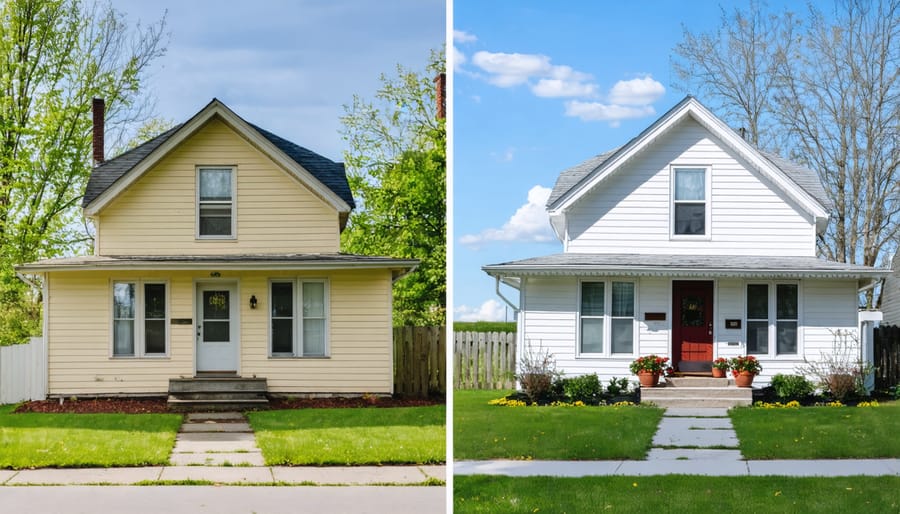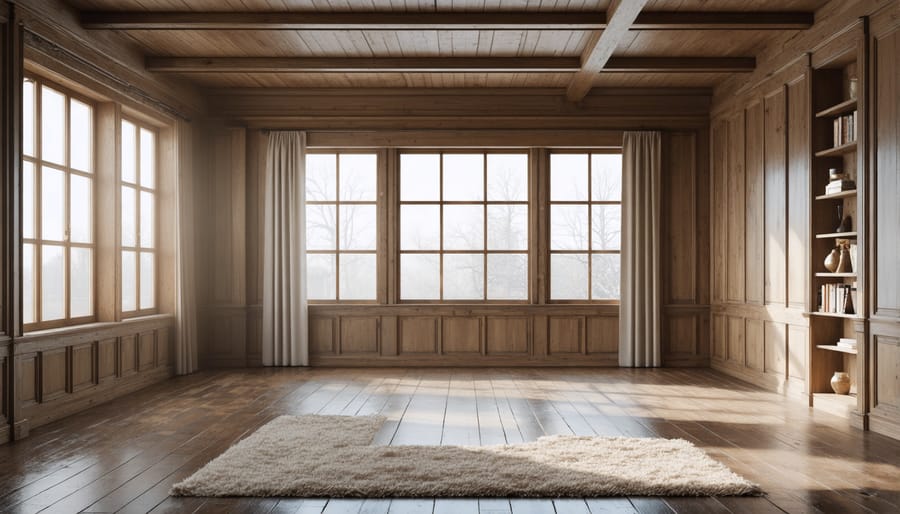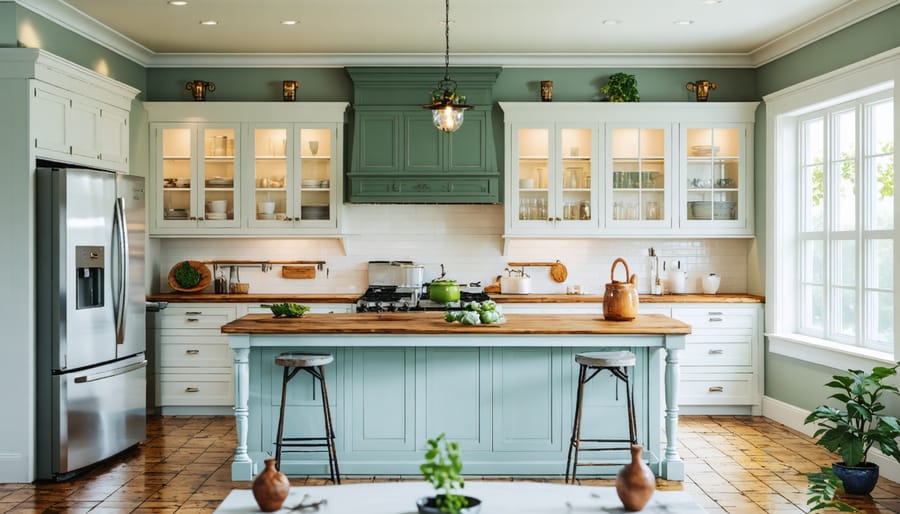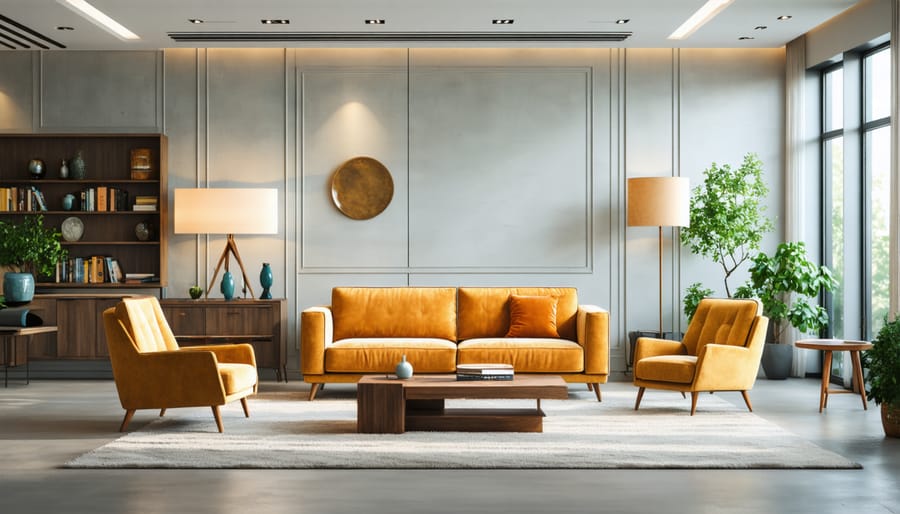Transform a dated mid-century home into a stunning modern masterpiece by preserving its architectural integrity while incorporating contemporary comforts. The mid-century modern revival has inspired countless homeowners to breathe new life into these architectural gems, celebrating their clean lines, organic forms, and seamless indoor-outdoor connections.
Our collection of dramatic before-and-after transformations showcases how original features like exposed beams, floor-to-ceiling windows, and distinctive rooflines can be enhanced while updating crucial elements for modern living. From preserving terrazzo floors and restoring original woodwork to incorporating smart home technology and energy-efficient solutions, these renovations demonstrate the perfect balance between honoring historical design and meeting contemporary needs.
Whether you’re planning a full-scale renovation or seeking inspiration for smaller updates, these transformations prove that thoughtful restoration can preserve the essence of mid-century architecture while creating spaces that work for today’s lifestyle. Each project reveals the potential hiding beneath decades of outdated finishes, showing how strategic changes can highlight the timeless appeal of mid-century design principles.
The Original Home: Capturing 1950s Charm

Key Mid-Century Features Worth Preserving
When renovating a mid-century modern home, certain architectural elements deserve special attention for their historical significance and design value. The distinctive flat or low-pitched roofs create clean lines that define the era’s aesthetic, while large windows and sliding glass doors forge that coveted indoor-outdoor connection characteristic of the style.
Original wood paneling, particularly in teak or walnut, often tells a home’s story and can be restored rather than replaced. The open floor plans with their floating stairs and built-in shelving units are architectural features worth preserving, as they showcase the innovation of mid-century design thinking.
Don’t overlook smaller details like original hardware, door handles, and light fixtures – these authentic pieces can become striking focal points when properly restored. Terrazzo flooring, if present, is a precious find that can be brought back to life with professional restoration. Even seemingly simple elements like exposed beams and original brick fireplaces contribute to the home’s architectural integrity and should be carefully considered before any modifications.
Remember that these features aren’t just about aesthetics; they’re tangible pieces of architectural history that add significant value to your home when properly preserved.
Common Challenges in 1950s Homes
While mid-century modern homes have timeless appeal, they often come with several common challenges that need addressing during renovation. Many of these homes struggle with outdated electrical systems, typically featuring two-prong outlets and insufficient power capacity for modern appliances. Single-pane windows, though characteristic of the era, usually provide poor insulation and energy efficiency.
Original bathroom and kitchen fixtures, while charming, frequently show significant wear and may contain hazardous materials like asbestos or lead pipes. The iconic flat or low-pitched roofs, while stylish, are prone to water damage and often need comprehensive waterproofing solutions. Many homes from this period also lack adequate insulation in walls and attics, leading to higher energy costs.
HVAC systems in these homes typically need complete overhauls, as original systems are inefficient by today’s standards. The open floor plans, while desirable, sometimes create heating and cooling challenges. Additionally, original wood paneling and built-ins might show extensive wear or water damage, requiring careful restoration or replacement to maintain the home’s authentic character.
Planning the Perfect Mid-Century Revival
Balancing Authenticity with Modern Living
The art of renovating a mid-century modern home lies in striking the perfect balance between preserving its historical character and incorporating modern conveniences. The key is to blend vintage with modern elements thoughtfully, ensuring neither overwhelms the other.
Start by identifying the defining features worth preserving: original wood paneling, distinctive window shapes, or built-in furniture. These elements tell your home’s story and shouldn’t be sacrificed for contemporary trends. Instead, look for ways to enhance them with modern touches. For instance, restore those gorgeous wooden cabinets but upgrade their hardware and add soft-close mechanisms.
When it comes to technology and comfort, focus on seamless integration. Hide smart home features behind period-appropriate covers, install energy-efficient windows that match the original style, and upgrade insulation without disturbing characteristic architectural details. In the kitchen, maintain the original layout while incorporating modern appliances in retro finishes.
The bathroom presents an excellent opportunity to mix eras. Keep the vintage tile if it’s in good condition but upgrade to water-efficient fixtures with a period-appropriate look. Consider adding modern luxuries like heated floors or smart mirrors in a way that complements rather than competes with the original design.
Remember, successful modernization shouldn’t erase your home’s mid-century charm but rather enhance its livability for today’s lifestyle.
Material Selection and Color Schemes
When reviving a mid-century modern home, material selection and choosing period-appropriate colors are crucial elements that can make or break your renovation. Start with authentic materials like warm-toned woods, particularly teak, walnut, and oak, which were staples of the era. Don’t shy away from mixing materials – combine wood with sleek metals like brass or chrome for that characteristic mid-century contrast.
For wall finishes, consider incorporating wood paneling or textured wallpaper in geometric patterns. Stone elements, particularly in fireplaces or accent walls, work beautifully when using materials like slate or terrazzo. For flooring, terrazzo, cork, or large-format ceramic tiles all speak to the period’s aesthetic while offering modern durability.
The mid-century color palette typically includes both bold and neutral tones. Earth tones like warm browns, mustard yellows, and olive greens create an authentic base. Accent with vibrant pops of color such as turquoise, burnt orange, or deep red. For a more subtle approach, stick to neutrals like warm grays and creamy whites, then add color through furniture and accessories.
Remember to balance authentic materials with modern performance – today’s engineered woods and synthetic materials can often provide the look you want with better durability and maintenance properties. The key is choosing materials and colors that honor the original style while meeting contemporary living needs.
The Transformation Process
Living Areas: Opening Up Space
The most dramatic transformations in mid-century modern renovations often happen in the living areas, where removing walls and opening up spaces can completely revolutionize a home’s flow. In our featured renovation, the original compartmentalized layout gave way to an airy, open-concept space that seamlessly connects the living and dining areas.
Before the renovation, dark wood paneling and closed-off rooms created a cave-like atmosphere typical of 1960s homes. The living room was isolated from the dining area by a load-bearing wall, and both spaces suffered from limited natural light. Heavy drapes and outdated light fixtures further contributed to the enclosed feeling.
The transformation began with carefully removing non-load-bearing walls and reinforcing the necessary structural elements. The newly opened space now showcases original terrazzo flooring, restored to its former glory and flowing continuously between areas. Large windows, previously hidden behind heavy treatments, now feature minimal blinds that celebrate the indoor-outdoor connection fundamental to mid-century design.
In the dining area, a dated chandelier was replaced with a Sputnik-style fixture that serves as both illumination and sculptural element. The restored original wood ceiling beams draw the eye upward, emphasizing the room’s height and architectural character.
Pro tip: When opening up spaces, consider sight lines and traffic flow. Our renovation maintained clear pathways while creating distinct zones through strategic furniture placement and area rugs, preserving the functionality of separate spaces within the open concept.
The result is a bright, welcoming environment that honors mid-century principles while meeting modern living needs. The space now feels twice as large, despite no change to the actual square footage.

Kitchen Modernization
The kitchen transformation stands as one of the most dramatic aspects of mid-century modern renovations, blending vintage charm with contemporary functionality. In the “before” state, many original mid-century kitchens feature dated laminate countertops, closed-off layouts, and worn cabinetry that doesn’t maximize storage potential.
Modern updates start with opening up the space, often removing walls to create the flowing layout characteristic of mid-century design. Sleek, flat-front cabinets in warm wood tones replace old units while maintaining the period’s aesthetic. Walnut and teak remain popular choices, though lighter options like white oak offer a fresh take on the classic look.
Countertops see a significant upgrade, with quartz or terrazzo providing durability while echoing mid-century patterns. The original Formica gives way to these sophisticated surfaces, often extending into waterfall edges on islands – a contemporary interpretation of mid-century clean lines.
Appliances receive a strategic update, incorporating stainless steel models that complement rather than compete with the overall design. Hidden panels can disguise modern refrigerators and dishwashers, maintaining the kitchen’s cohesive look. Statement pieces like colorful stand mixers or vintage-inspired ranges serve as functional art pieces.
Lighting transforms from fluorescent boxes to architectural elements, with sputnik-style chandeliers or globe pendants illuminating work areas. Under-cabinet lighting adds modern functionality while preserving the original aesthetic. Original features worth saving, like metal cabinet hardware or period tile work, can be restored and incorporated into the new design.
The backsplash offers an opportunity to introduce geometric patterns or subtle texture, using materials like elongated subway tiles or mosaic designs that reference mid-century motifs. Color palettes typically combine warm woods with whites and bold accent colors – think olive green, mustard yellow, or deep orange – used strategically to create visual interest without overwhelming the space.

Bathroom Revival
The bathroom transformation from dated fixtures to mid-century modern elegance is one of the most dramatic aspects of any renovation project. In vintage homes, you’ll often find pastel-colored tiles and worn-out vanities that scream for an update. The key to a successful bathroom revival lies in balancing authentic mid-century elements with modern functionality.
Start by stripping away outdated features while preserving any original elements worth saving, like terrazzo flooring or vintage wall tiles in good condition. Replace bulky vanities with floating versions featuring clean lines and walnut finishes – a hallmark of mid-century design. Consider installing a statement mirror with integrated lighting or a sunburst design to create a focal point.
For tiles, opt for geometric patterns or classic penny rounds in period-appropriate colors like olive green, mustard yellow, or classic black and white. Large-format rectangular tiles in a stacked pattern can also provide a contemporary take on mid-century aesthetics. Don’t forget the fixtures – brass or matte black hardware adds warmth and authenticity to the space.
Lighting plays a crucial role in bathroom renovations. Globe sconces flanking the mirror or a single dramatic pendant light can transform the ambiance while staying true to mid-century principles. For smaller bathrooms, consider installing a skylight to bring in natural light – a common feature in original mid-century homes.
Storage solutions should be both functional and stylish. Open shelving with warm wood tones or sleek built-in cabinets can house essentials while maintaining the clean, uncluttered look characteristic of mid-century modern design. Remember, the goal is to create a space that feels both nostalgic and fresh, combining the best of both eras.
Finishing Touches
Authentic Mid-Century Furniture Selection
When selecting furniture for your mid-century modern renovation, authenticity is key to achieving that coveted retro aesthetic. Start by focusing on pieces with clean lines, organic shapes, and mixed materials like teak, walnut, and molded plastic. Look for iconic designers like Eames, Knoll, and Herman Miller, but don’t feel pressured to buy only originals – quality reproductions can work well within your budget.
For seating, prioritize low-profile pieces with tapered legs and minimal upholstery. A classic Eames lounge chair or a sleek Danish modern sofa can serve as striking focal points. Complement larger pieces with period-appropriate accents like sputnik chandeliers, sunburst mirrors, and geometric patterns.
When sourcing furniture, explore vintage shops, estate sales, and online marketplaces. Remember to check for quality markers like dovetail joints and original hardware. Mix authentic vintage pieces with contemporary items that honor mid-century design principles – this creates a livable space that doesn’t feel like a museum.
Consider scale carefully – mid-century furniture typically features a lighter, more floating appearance that works well in both small and large spaces. Don’t forget to incorporate natural elements and abstract art to complete the authentic mid-century look.

Lighting and Hardware Updates
One of the most impactful ways to honor mid-century modern design is through authentic lighting design choices and hardware details. In our renovation, we swapped out generic builder-grade fixtures for iconic sputnik chandeliers and sleek globe pendants that instantly elevated each space. The living room’s original brass sconces were carefully restored, while period-appropriate atomic starburst fixtures were installed in the dining area.
Hardware updates played an equally crucial role in achieving that authentic MCM feel. We replaced standard doorknobs with streamlined brass pulls, featuring clean geometric shapes characteristic of the era. Cabinet hardware was updated with slender, minimalist bars in brushed gold, while bathroom fixtures received matte black replacements with angular profiles.
The magic lies in mixing authentic vintage pieces with modern reproductions. We sourced several original pieces from estate sales and vintage shops, then complemented them with high-quality reproductions that capture the essence of mid-century design while offering modern functionality and safety features. Remember, even small hardware updates can make a dramatic impact on your home’s overall aesthetic.
Embarking on a mid-century modern renovation journey can feel overwhelming at first, but the transformative results make it all worthwhile. As we’ve seen through various examples, these renovations can breathe new life into dated spaces while preserving the distinctive charm of mid-century architecture. Whether you’re planning a complete overhaul or exploring budget-friendly renovation ideas, success lies in thoughtful planning and respect for original design elements.
Remember to start with thorough research and documentation of your space’s existing features. Focus on maintaining clean lines, incorporating natural materials, and balancing vintage elements with modern conveniences. Don’t be afraid to take it step by step – many successful renovations happen in phases rather than all at once.
For those ready to begin their own mid-century modern transformation, keep these final tips in mind: preserve original architectural details whenever possible, invest in quality materials that match the era’s aesthetic, and work with professionals who understand mid-century design principles. Most importantly, stay true to your vision while respecting the home’s original character.
The beauty of mid-century modern renovation lies in creating spaces that honor the past while embracing contemporary living. With careful planning, attention to detail, and a clear vision, you can achieve a stunning transformation that stands the test of time.
